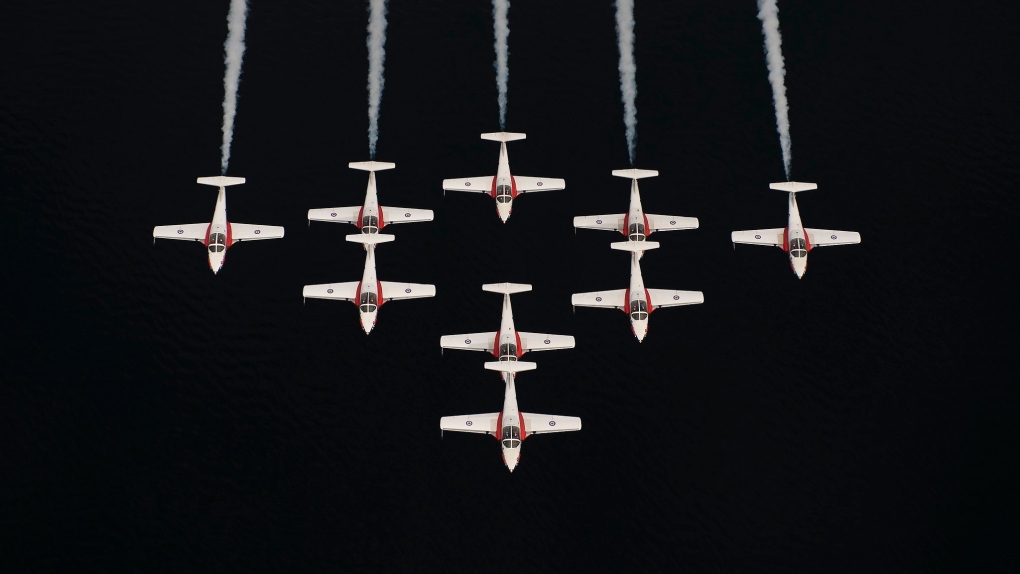Snowbirds grounded after problem discovered with emergency ejection parachute
 The Canadian Forces Snowbirds fly in Silver Dart formation over the Strait of Georgia while training at 19 Wing Comox. (Department of National Defence/Sgt Robert Bottrill)
The Canadian Forces Snowbirds fly in Silver Dart formation over the Strait of Georgia while training at 19 Wing Comox. (Department of National Defence/Sgt Robert Bottrill)
A problem with the aircraft's emergency ejection parachute has grounded the Canadian Forces Snowbirds for the foreseeable future.
The Department of National Defence said Friday the iconic aerobatic team will not fly in upcoming airshows and flybys until a problem with the timing device that releases the parachute during an emergency ejection is fixed.
The military says the issue was discovered during maintenance on parachutes aboard the CT-114 Tutor aircraft flown by the Snowbirds team.
Airplane technicians at 15 Wing Moose Jaw, in Saskatchewan, found on June 19 that the timing device may not be calibrated correctly, according to a National Defence statement.
"Out of an abundance of caution, the parachutes currently being used by aircrew flying in CT-114 Tutor aircraft will now be re-tested and re-packed, as necessary, to ensure proper timing is set for their activation in the event of an emergency," the department said.
The Royal Canadian Air Force is working with a third-party contractor to fix the problem, with no timeline for completion in sight, according to the military.
The air force expects that upcoming performances scheduled for next week in New Brunswick will be cancelled. Technicians are working to get the aging Tutor jets back in the air for Canada Day celebrations in Ottawa, according to the military.
"While it is certainly disappointing the Snowbirds anticipate they will need to cancel upcoming performances until this technical issue is resolved, I applaud our aviation technicians for discovering this issue," said 1 Canadian Air Division commander Maj.-Gen. Eric Kenny in a statement.
"We have full confidence that this issue will be resolved in a safe manner, working with a third-party aviation contractor and our own technical and maintenance experts," Kenny added.
The air force says the issue with the parachute timing device is not related to the fatal crash of the Snowbirds jet that killed public affairs officer Capt. Jenn Casey in Kamloops, B.C., in May 2020.
PRIOR PARACHUTE ISSUES
One month after the fatal Kamloops crash, a military investigation into an earlier crash was released, finding that the ejection seat of a Snowbirds aircraft became tangled with the pilot's parachute as he tried to escape his plane before hitting the ground in 2019.
The pilot sustained minor injuries and the Tutor jet was destroyed after slamming into a farmer's field while en route to an airshow in Atlanta, Ga.
Investigators determined the entanglement prevented the parachute from opening properly.
The report found the most likely cause of the parachute malfunction was the release of one or more parachute pack cones before the timing device was activated.
"Entanglement of the suspension lines with parts of the ejection seat immediately followed, ultimately disrupting the proper opening of the parachute canopy," according to a summary of the report.
"Inspection of all related Tutor aviation life support equipment was subsequently carried out to ensure fleet airworthiness."
CTVNews.ca Top Stories

From outer space? Sask. farmers baffled after discovering strange wreckage in field
A family of fifth generation farmers from Ituna, Sask. are trying to find answers after discovering several strange objects lying on their land.
NEW Iconic Canadian song turns 50
Andy Kim's 'Rock Me Gently' is marking a major milestone, as it celebrates its 50th anniversary.
Oprah Winfrey: I set an unrealistic standard for dieting
Oprah Winfrey said on Thursday evening that she has long played a role in promoting unhealthy and unrealistic diets.
Prince Harry, Meghan arrive in Nigeria to champion the Invictus Games and meet with wounded soldiers
Prince Harry and his wife, Meghan, arrived in Nigeria on Friday to champion the Invictus Games, which he founded to aid the rehabilitation of wounded and sick servicemembers and veterans, among them Nigerian soldiers fighting a 14-year war against Islamic extremists.
Countries struggle to draft 'pandemic treaty' to avoid mistakes made during COVID
After the coronavirus pandemic triggered once-unthinkable lockdowns, upended economies and killed millions, leaders at the World Health Organization and worldwide vowed to do better in the future. Years later, countries are still struggling to come up with an agreed-upon plan for how the world might respond to the next global outbreak.
Toronto police called to Drake's Bridle Path mansion for another alleged intruder on Thursday
Toronto police say a man who allegedly attempted to access Drake’s Bridle Path property was taken to hospital on Thursday after an altercation with security guards.
Ontario family receives massive hospital bill as part of LTC law, refuses to pay
A southwestern Ontario woman has received an $8,400 bill from a hospital in Windsor, Ont., after she refused to put her mother in a nursing home she hated -- and she says she has no intention of paying it.
Flat tire on a highway? Here's why you shouldn't try to fix it
If you're cruising down a highway and realize you have a flat tire, you may want to think twice before stopping to fix it on the side of the road.
Storm-battered U.S. South is again under threat. A boy swept into a drain fights for his life
Dangerous storms crashed over parts of the U.S. South on Thursday even as the region cleaned up from earlier severe weather that spawned tornadoes, killed at least three people, and gravely injured a boy who was swept into a storm drain as he played in a flooded street.

































